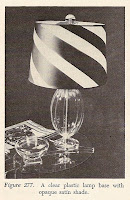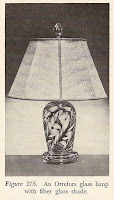Electricity applauded, 65 years ago
 Did your parents or grandparents have electricity in their house by 1942? If they lived in a rural area, it's very likely that they did not. In 1939, just 25% of rural homes were electrified.
Did your parents or grandparents have electricity in their house by 1942? If they lived in a rural area, it's very likely that they did not. In 1939, just 25% of rural homes were electrified.In this part of Kentucky, the Pennyrile Rural Electric Cooperative brought electricity to rural homes. Pennyrile Electric was organized in 1937, but out here, some of the old-timers reminisce that they didn't get electricity until the early 1950s. I don't know if that was because electricity wasn't available earlier, or because of reluctance in some families to install electricity.
In Decorating the Home, a 1942 interior-decorating textbook, Ethel Lewis writes about some of the latest electrical gadgets.
Electricity and light are so nearly synonymous today that some of the newest electrical devices can be listed here.
In addition to all the labor-saving equipment, there is the electric clock, the fan, and most of us depend upon electricity to run the radio and the automatic-change phonograph.
For the nursery there is the "seeing eye" which protects the crib and so warns of the approach of thieves or kidnappers.
The ray from the photoelectric cell is the unseen source which opens doors so miraculously as a person approaches.
Perhaps nothing appeals more to the mechanically minded than the automatic window closer which works so swiftly when the alarm sounds the hour for rising.
The control and use of electricity are certainly one of man's greatest achievements, and many a home is a better place in which to live because of it.
Let electricity work for you; let it help you to preserve your eyesight.
From Decorating the Home (p. 127) by Ethel Lewis. (Published in New York by the Macmillan Company in 1942.) The lamp images in this post are also from Decorating the Home.
 Did you notice? The electric refrigerator, electric range, electric water heater, and electric clothes washer aren't even mentioned, though they totally changed women's lives. They're part of the "labor-saving equipment" that Lewis breezes over.
Did you notice? The electric refrigerator, electric range, electric water heater, and electric clothes washer aren't even mentioned, though they totally changed women's lives. They're part of the "labor-saving equipment" that Lewis breezes over.I must admit that I take them for granted also -- as long as my electrical appliances work, I don't give them the grateful appreciation that they deserve.
2 comments:
The seeing eye was actually invented after the infamous kidnapping of the Lindberger baby, which is why they say that it warns against the approach of kidnappers. They were the early version of the baby monitor.
Hi, Keely. I wonder if the "seeing eye" might have been a motion detector that set off an alarm? I can't find any info in a quick Google search, but I did learn about the Zenith "Radio Nurse."
Post a Comment